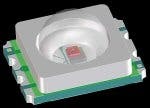Cree introduces first packaged LED product
The 7090 XLamp series has a footprint of 7 x 9 mm and is designed to operate at 350 mA. Blue, cyan, green and white XLamps are based on Cree's InGaN-on-SiC XB-900 chip, while red and amber products incorporate chips from external suppliers. The 4550 series has a smaller footprint of 4.5 x 5 mm and operates at 125 mA.
LEDs Magazine spoke with Norbert Hiller, vice president of Cree Lighting about the new XLamp products.
Why did Cree choose to enter the lighting market?
NH. In the past when Cree has introduced chips we have seen a very fast response from customers to bring the chips to market in their packaged products. With our power chips it took a very long time before products emerged, so we decided that we needed to stimulate the market by introducing our own packaged products.
Is there a risk of conflict with your chip customers?
NH. We will continue to sell our standard and power chips to anyone who wants to buy them, without restrictions. We had discussions both internally and with customers, and we don't see it as a source of conflict. Cree Lighting is focused on high-power packaged LEDs, and is separate from Cree's chip business.
What technology is used for white?
NH. Our white LEDs use a blue chip around 470 nm with a downconversion phosphor. We would have liked to use our UV chip, which is one of the most efficient in the market, but we haven't found a UV-pumped phosphor that is as efficient as the combination that we're using in production.
What are the performance characteristics of the white XLamp product?
NH. The white XLamp produces about 30 lm when operated at 350 mA. This is at least as bright as - and in many cases brighter than - the upper end of competing products already in the market. The forward voltage is typically 3.4 V, corresponding to an input power of around 1 W .
The color temperature is in the 5000-6000K range at the moment. Various markets are also asking for warmer white colors, and we are looking into developing these products using different phosphor blends. Unfortunately there is a trade-off in lumen output when moving to warmer white as the phosphors are less efficient.
What is the significance of your modular package design?
NH. We think we have chosen a very robust, straightforward design that combines the chip on a submount with a lens, reflector, heat sink and baseplate. Not only is this design compatible with high volume manufacturing, but also we have the flexibility to make modifications to the different components. This allows us to optimize performance and also cost, depending on the demands of our different customers and end markets.
Where is XLamp production carried out?
NH. Initial production is being performed at Cree's headquarters in Durham, North Carolina, alongside our chip manufacturing operation. It's possible that Cree may decide to invest in an overseas production facility in the future.
What future improvements are likely to be made to device performance?
NH. Cree is developing more efficient devices that can be integrated into packages to produce more lumens per watt. At the same time, we're driving costs down by increasing yields and also converting our chip production from 2-inch to 3-inch wafers over the coming year.








